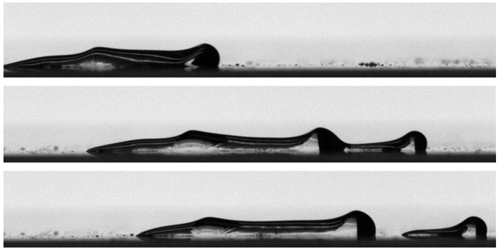Droplets Scoot Like Caterpillars
From swells in an ocean to ripples in a puddle, the shearing effect of wind blowing over a liquid is visible at all scales. This shear determines the interactions between Earth’s atmosphere and its surface water and, researchers now explain, the movement of liquid droplets that crawl up and down the window of a moving car in the rain. In a series of experiments, Antonio Chahine of the University of Toulouse, France, and his colleagues show that airflow triggers surface waves that cause such droplets to crawl like caterpillars before they break apart [1].
The team placed a 40-to-100-µL glycerin droplet on a horizontal glass surface in a wind tunnel blowing at 20 m/s (equivalent to a gale on the Beaufort scale). At first, the airflow across the droplet’s surface caused the droplet to extend into an oval shape. The droplet also began to tilt, with the liquid piling up at the droplet’s downwind edge. When the drag force exerted by the airflow overcame the capillary force between the glycerin and the glass, the droplet began to slide and to stretch out even more. Surface waves then developed on the elongated droplet and traveled toward its leading edge. The waves induced a stable caterpillar-like motion, with the droplet stretching and contracting along its length. Eventually, beyond a threshold length that depended on the droplet’s volume, the caterpillar was no longer able to withstand the shearing force and broke into several droplets.
The researchers say that the behavior follows the same pattern as that of an elongated droplet sliding along an incline. The information adds a new component to describing how droplets transport and distribute materials along surfaces.
–Rachel Berkowitz
Rachel Berkowitz is a Corresponding Editor for Physics Magazine based in Vancouver, Canada.
References
- A. Chahine et al., “Caterpillar like motion of droplet in a shear flow,” Phys. Rev. Fluids 8, 093601 (2023).




